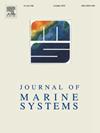西北印度洋涡旋不同生命阶段瓦兰尼须鲸的时空分布
IF 2.5
3区 地球科学
Q2 GEOSCIENCES, MULTIDISCIPLINARY
引用次数: 0
摘要
中尺度涡旋,特别是气旋涡旋(CEs),是影响西北印度洋紫背飞乌贼资源丰富度和分布的重要因素。Sthenoteuthis wallaniensis是一种短命物种,对环境变化敏感。ce的演变伴随着结构和能量的转变,对当地海洋环境产生不同的影响。然而,S. oualaniensis对这些进化的ce的反应尚不清楚。因此,本研究分析了ce演化过程中基本涡旋特征的变化以及ce驱动的环境变化(海表温度、叶绿素-a浓度和150 m深度溶解氧浓度)。结合生境适宜性指数(HSI)模型,分析了华氏沙蚕在不同生活阶段的分布。结果表明,ce的生长经历了早期、成熟期和衰老期三个阶段。在不同阶段,ce参数呈现出不同的分布格局。随着涡旋的演化,南纬和经度丰度的重心呈现出与涡旋中心相似的运动轨迹。这一演化过程所驱动的环境变化影响了华氏沙蚕的分布,其最大适宜生境面积在华氏沙蚕成熟期形成。这些结果表明,印度洋西北海域的ce演化对S. oualaniensis的生境分布有显著影响。本文章由计算机程序翻译,如有差异,请以英文原文为准。
Spatial and temporal distribution of Sthenoteuthis oualaniensis in the Northwest Indian Ocean during different life stages of cyclonic eddies
Mesoscale eddies, particularly cyclonic eddies (CEs), are known to influence the abundance and distribution of purpleback flying squid (Sthenoteuthis oualaniensis) resources in the northwest Indian Ocean. Sthenoteuthis oualaniensis is a short-lived species and is sensitive to environmental changes. The evolution of CEs is accompanied by structural and energetic transformations, exerting varying impacts on the local marine environment. However, the response of S. oualaniensis to these evolving CEs remains unclear. Therefore, this study analyzed the changes in basic eddy characteristics during CEs evolution and the environmental changes (sea surface temperature, chlorophyll-a concentration, and dissolved oxygen concentration at 150 m depth) driven by CEs. Combined with a habitat suitability index (HSI) model, the distribution of S. oualaniensis during the different life stages of CEs was analyzed. The results showed that the CEs experienced three stages: the early stage, the mature stage and the aged stage. At different stages, the parameters of CEs exhibited distinct distribution patterns. As the eddy evolved, the gravity center of S. oualaniensis abundance in latitude and longitude exhibited a movement trajectory similar to the eddy center. The environmental changes driven by this evolution process influenced the distribution of S. oualaniensis, and the maximum suitable habitat area was generated during the CEs mature stage. These results show that the evolution of CEs significantly affects the habitat distribution of S. oualaniensis in the northwest Indian Ocean.
求助全文
通过发布文献求助,成功后即可免费获取论文全文。
去求助
来源期刊

Journal of Marine Systems
地学-地球科学综合
CiteScore
6.20
自引率
3.60%
发文量
81
审稿时长
6 months
期刊介绍:
The Journal of Marine Systems provides a medium for interdisciplinary exchange between physical, chemical and biological oceanographers and marine geologists. The journal welcomes original research papers and review articles. Preference will be given to interdisciplinary approaches to marine systems.
 求助内容:
求助内容: 应助结果提醒方式:
应助结果提醒方式:


